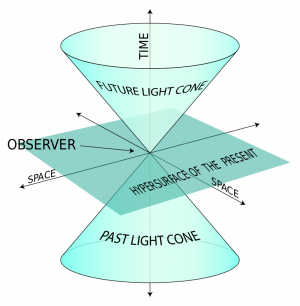Einstein’s equations in his Special Theory of Relativity have brought strange new insights into the universe, and one of them is time dilation. Sometimes called time relativity, time dilation states that time flows at different speeds depending on relative motion. This means that the passing of time will not be the same for two individuals moving at different speeds. Two clocks that have been set simultaneously and then set out to move in space at different speeds will not hold the same time.
Clocks, Speed, and Time
At normal, everyday speeds here on Earth, time dilation is almost imperceptible. However, this does not mean that they do not exist here, as highly-sensitive scientific instruments have already confirmed their occurrence. Time dilation only becomes more observable when a traveling object approaches relativistic speeds or the speed of light. As a hypothetical scenario, if a stationary observer could see inside the spaceship traveling at 99 percent of the speed of light, the observer would notice that the clock inside the spaceship runs twice as slow compared to an ordinary clock. This will be accompanied by the astronauts in the spaceship seeming to move in slow motion. If the spaceship increases its speed to 99.5 percent of the speed of light, the observer will notice that the clock in the spaceship is now running approximately ten times slower than a normal clock. If the spaceship further increases its speed to 99.9 percent of the speed of light, the observer will see that the clock has now slowed down 22 times in comparison, and at 99.99 percent of the speed of light, the slowness of the clock would be at a factor of 224. Then, at 99.999 percent, it will be 707 times.
Here on Earth, the only way scientists can propel minute objects to tremendous speeds is by using large particle accelerators, which can slow down time by 100,000 times. In theory, once an object reaches the speed of light, time stops.
Length Contraction
Time dilation may already seem strange as it is, but another strange phenomenon accompanies objects traveling at relativistic speeds. This phenomenon is identified by physicists as length contraction, which is the foreshortening of the traveling body towards the direction it is heading. The actual shape of the traveling body becomes distorted because of the speed at which it is moving.
An ordinary analogy can perhaps simplify these strange occurrences that accompany objects traveling at relativistic speeds: A person who walks towards the northwest is automatically traveling from one point to another while time is flowing. To an observer, this walking person may not be exhibiting length contraction, but his northwest movement is shared by both the direction to his north and the direction to his west. Physicists look at this sharing of spatial and temporal dimensions as an effect of the speed of light (almost 300,000 kilometers per second), which acts as a speed limit for everything in the universe.
Einstein’s Time and Newton’s Time
As Einstein has shown in his equations, time dilation depends on the observer and whether or not the observer is stationary or moving along with the observed object. This may sound like the flow of time is wayward and unpredictable, but it is not. The flow of time obeys the laws of physics and can indeed be predicted, as has been shown by the special theory of dilation. However, because of the publication of Einstein’s work, much has changed in the understanding of the nature of time. Isaac Newton thought that time was absolute and that it flowed at the same rate everywhere in the universe.
In connection with this, the philosopher named William Lane Craig proposed that the reality of time and the measurement of time should be clarified and distinguished from each other. Though his proposal is not widely accepted among physicists, it arises from his suspicion that time may be absolute after all but that human measurement may be relativistic.
Simultaneity
Time dilation also introduced the concept of simultaneity, where two occurrences can happen at the same moment from a certain viewpoint. Relativistic physics holds that simultaneity is not an absolute characteristic of any two events, as two events that happened at the same time from one standpoint may not look like they happened at the same time from another standpoint. This notion had never been questioned seriously until the advent of Einstein’s theories. And here again, the speed at which the observed objects come into play. Objects that travel at ordinary speeds usually display simultaneity, and in their case, simultaneity can be considered an absolute characteristic. Meanwhile, simultaneity may not be observed anymore with objects that travel near the speed of light.
The Twin Paradox
One consequence of time dilation is the popularization of the twin paradox, wherein an imaginary astronaut boards a spaceship, goes on a round-trip journey in space at almost the speed of light, then comes back to Earth. The astronaut will then be surprised to see that his twin brother had aged much older than him. Traveling at relativistic speeds slowed down the astronaut’s body, which is itself a biological clock, and this caused him to age only one year. Meanwhile, his twin brother, who stayed on Earth, had aged ten years.
Einstein explained that this paradox only seems like a paradox because humans are used to thinking of time surrounding their lives as the “true time,” or preferred frame of reference. However, in this twin paradox, the astronaut’s time inside the spaceship can also be treated as the preferred frame of reference. And if it was treated as such, then the object that traveled near the speed of light would be Earth, and the object that remained at rest was the astronaut.
